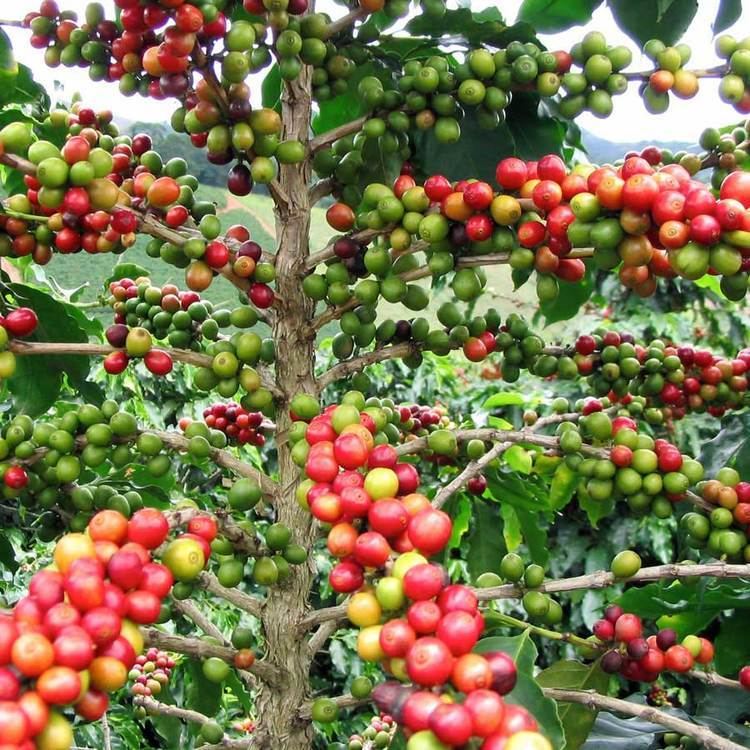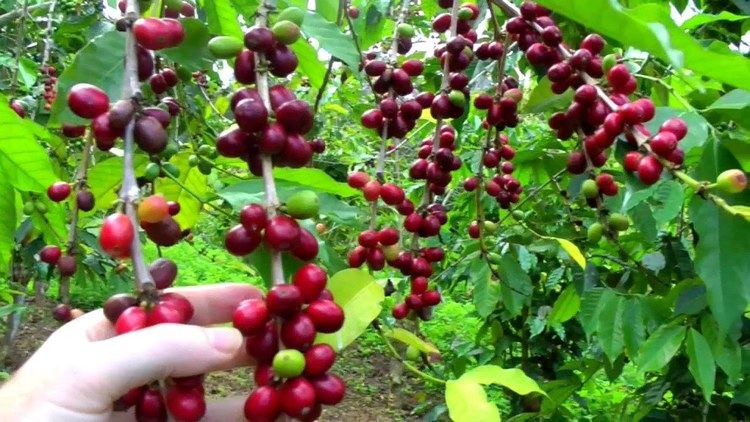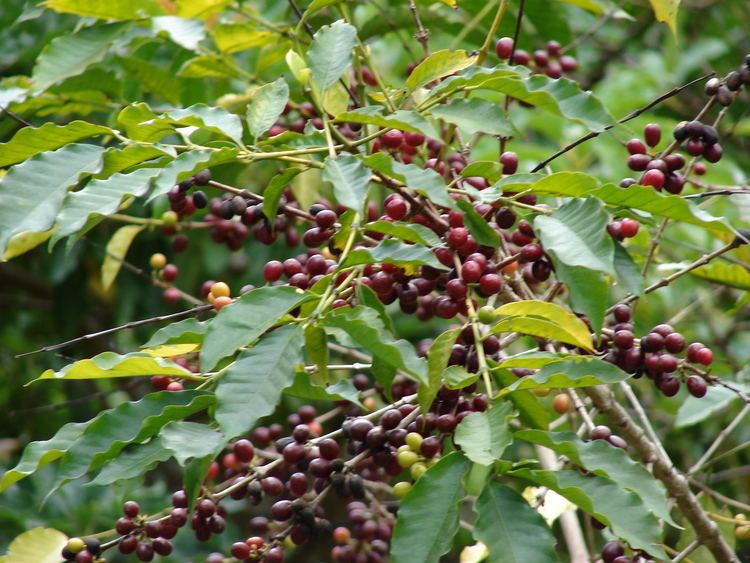Tribe Coffeeae Higher classification Coffee | Subfamily Ixoroideae Genus Coffea Rank Species | |
Similar | ||
Coffea arabica growing and planting seedlings
Coffea arabica /əˈræbɪkə/ is a species of Coffea originally indigenous to the forests of the southwestern highlands of Ethiopia. It is also known as the "coffee shrub of Arabia", "mountain coffee", or "arabica coffee". C. arabica is believed to be the first species of coffee to be cultivated, and is by far the dominant cultivar, representing some 70% of global production. Coffee produced from the less acidic, more bitter, and more highly caffeinated robusta bean (C. canephora) makes up the preponderance of the balance.
Contents
- Coffea arabica growing and planting seedlings
- Make a cup of coffee starting from scratch coffea arabica video
- Biology
- Distribution and habitat
- Cultivation and use
- History and legend
- Taxonomy
- Strains
- References

Make a cup of coffee starting from scratch coffea arabica video
Biology

Wild plants grow between 9 and 12 m (30 and 39 ft) tall, and have an open branching system; the leaves are opposite, simple elliptic-ovate to oblong, 6–12 cm (2.5–4.5 in) long and 4–8 cm (1.5–3 in) broad, glossy dark green. The flowers are white, 10–15 mm in diameter and grow in axillary clusters. The seeds are contained in a drupe (commonly called a "cherry") 10–15 mm in diameter, maturing bright red to purple and typically contains two seeds (the coffee seeds).
Distribution and habitat

Endemic to the mountainous regions of Yemen and the southwestern highlands of Ethiopia, C. arabica is now rare in Ethiopia, while many populations appear to be of mixed native and planted trees. In Ethiopia, where it is called būna, it is commonly used as an understorey shrub. It has also been recovered from the Boma Plateau in South Sudan. C. arabica is also found on Mount Marsabit in northern Kenya, but it is unclear whether this is a truly native or naturalised occurrence. The species is widely naturalised in areas outside its native land, in many parts of Africa, Latin America, Southeast Asia, China, and assorted islands in the Caribbean and in the Pacific.

The conservation of the genetic variation of C. arabica relies on conserving healthy populations of wild coffee in the Afromontane rainforests of Ethiopia. Genetic research has shown coffee cultivation is threatening the genetic integrity of wild coffee because it exposes wild genotypes to cultivars. Nearly all of the coffee that has been cultivated over the past few centuries originated with just a handful of wild plants from Ethiopia, and today the coffee growing on plantations around the world contains less than 1% of the diversity contained in the wild in Ethiopia alone.
Cultivation and use

Arabica coffee's first domestication in Ethiopia is obscure, but cultivation in Yemen is well documented by the 12th century.
Coffea arabica accounts for 70% of the world's coffee production.

C. arabica takes about seven years to mature fully, and does best with 1.0–1.5 meters (about 40–59 inches) of rain, evenly distributed throughout the year. It is usually cultivated between 1,300 and 1,500 m altitude, but plantations grow it as low as sea level and as high as 2,800 m.

The plant can tolerate low temperatures, but not frost, and does best with an average temperature between 15 and 24 °C (59 and 75 °F). Commercial cultivars mostly only grow to about 5 m, and are frequently trimmed as low as 2 m to facilitate harvesting. Unlike Coffea canephora, C. arabica prefers to be grown in light shade.
Two to four years after planting, C. arabica produces small, white, highly fragrant flowers. The sweet fragrance resembles the sweet smell of jasmine flowers. Flowers opening on sunny days result in the greatest numbers of berries. This can be a curse, however, as coffee plants tend to produce too many berries; this can lead to an inferior harvest and even damage yield in the following years, as the plant favours the ripening of berries to the detriment of its own health.
On well-kept plantations, overflowering is prevented by pruning the tree. The flowers only last a few days, leaving behind only the thick, dark-green leaves. The berries then begin to appear. These are as dark green as the foliage, until they begin to ripen, at first to yellow and then light red and finally darkening to a glossy, deep red. At this point, they are called “cherry” and are ready for picking.
The berries are oblong and about 1 cm long. Inferior coffee results from picking them too early or too late, so many are picked by hand to be able to better select them, as they do not all ripen at the same time. They are sometimes shaken off the tree onto mats, which means ripe and unripe berries are collected together.
The trees are difficult to cultivate and each tree can produce from 0.5 to 5.0 kg of dried beans, depending on the tree's individual character and the climate that season. The real prize of this cash crop are the beans inside. Each berry holds two locules containing the beans. The coffee beans are actually two seeds within the fruit; sometimes, a third seed or one seed, a peaberry, grows in the fruit at tips of the branches. These seeds are covered in two membranes; the outer one is called the "parchment coat" and the inner one is called the "silver skin".
On Java Island, trees are planted at all times of the year and are harvested year round. In parts of Brazil, however, the trees have a season and are harvested only in winter. The plants are vulnerable to damage in poor growing conditions (cold, low pH soil) and are also more vulnerable to pests than the C. robusta plant.
Arabica coffee production in Indonesia began in 1699. Indonesian coffees, such as Sumatran and Java, are known for heavy body and low acidity. This makes them ideal for blending with the higher acidity coffees from Central America and East Africa.
In Hawaii, coffee was formerly more widely grown than at present, and it persists after cultivation in many areas. In some valleys, it is a highly invasive weed. In the Udawattakele and Gannoruwa Forest Reserves near Kandy, Sri Lanka, coffee shrubs are also a problematic invasive.
It is expected that a medium-term depletion of indigenous populations of C. arabica may occur, due to projected global warming, based on IPCC modelling.
Climate change—rising temperatures, longer droughts, excessive rainfall—appears to threaten the sustainability of arabica coffee production.
Gourmet coffees are almost exclusively high-quality mild varieties of arabica coffee, and among the best known arabica coffee beans in the world are those from Jamaican Blue Mountain, Colombian Supremo, Tarrazú, Costa Rica, Guatemalan Antigua, and Ethiopian Sidamo. Espresso typically is made from a blend of arabica and robusta beans.
History and legend
According to legend, human cultivation of coffee began after goats in Ethiopia were seen mounting each other after eating the leaves and fruits of the coffee tree. In Ethiopia, people in some locales still drink a herbal tea made from the leaves of the coffee tree.
The first written record of coffee made from roasted coffee beans comes from Arab scholars, who wrote that it was useful in prolonging their working hours. The Arab innovation in Yemen of making a brew from roasted beans, spread first among the Egyptians and Turks, and later on found its way around the world. Other scholars believe that the coffee plant was introduced into Yemen from Abyssinia, based on a Yemeni tradition that slips of both coffee and qat were planted at 'Udein' ('the two twigs') in Yemen in pre-Islamic times. The Indian Version of the Arabica Coffee or Mocha Coffee which is grown in a place called Arehalli is known as Arehalli Koffee. The first crop of Arehalli Koffee was yielded in the Year 1918 in India.
Taxonomy
Coffea arabica was first described by Antoine de Jussieu, who named it Jasminum arabicum after studying a specimen from the Botanic Gardens of Amsterdam. Linnaeus placed it in its own genus Coffea in 1737.
Strains
One strain of Ethiopian Coffea arabica naturally contains very little caffeine. While beans of normal C. arabica plants contain 12 mg of caffeine per gram of dry mass, these mutants contain only 0.76 mg of caffeine per gram, but with all the taste of normal coffee.
